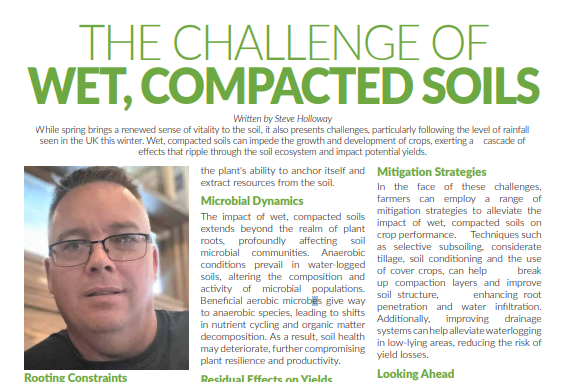Written by Steve Holloway from Soil Fertility Services
While spring brings a renewed sense of vitality to the soil, it also presents challenges, particularly following the level of rainfall seen in the UK this winter. Wet, compacted soils can impede the growth and development of crops, exerting a cascade of effects that ripple through the soil ecosystem and impact potential yields.

Rooting Constraints: Excess moisture and compaction create hostile conditions for plant roots, hindering their ability to penetrate the soil and access essential nutrients. In waterlogged soils, Oxygen levels plummet, leading to root suffocation and reduced nutrient uptake. Compaction further exacerbates this issue, restricting root elongation and lateral spread; limiting the plant’s ability to anchor itself and extract resources from the soil.
Microbial Dynamics: The impact of wet, compacted soils extends beyond the realm of plant roots, profoundly affecting soil microbial communities. Anaerobic conditions prevail in water-logged soils, altering the composition and activity of microbial populations. Beneficial aerobic microbes give way to anaerobic species, leading to shifts in nutrient cycling and organic matter decomposition. As a result, soil health may deteriorate, further compromising plant resilience and productivity.
Residual Effects on Yields: The consequences of wet, compacted soils can linger long after the rains have subsided. Crop yields may suffer due to stunted root growth, nutrient deficiencies and increased susceptibility to pests and diseases. Compaction scars the soil, leaving behind physical barriers that impede root penetration and water infiltration, perpetuating the cycle of poor soil structure and reduced productivity.
Mitigation Strategies: In the face of these challenges, farmers can employ a range of mitigation strategies to alleviate the impact of wet, compacted soils on crop performance. Techniques such as selective subsoiling, considerate tillage, soil conditioning and the use of cover crops, can help break up compaction layers and improve soil structure, enhancing root penetration and water infiltration. Additionally, improving drainage systems can help alleviate waterlogging in low-lying areas, reducing the risk of yield losses.
Looking Ahead: As we navigate the complexities of springtime soil management, it is essential to recognise the interconnectedness of soil, crops, and microbial life. By adopting holistic approaches that prioritise soil health and resilience, farmers can mitigate the impact of wet, compacted soils on crop yields while fostering sustainable agricultural systems that endure for generations to come.
Soil Matters! Corrective measures
Using metals, can be counter intuitive.
Biology – NOT metal makes tilth. Optimising it’s living conditions with bio-positive actions will promote structured aggregation; meaning that water ponds less, plant rooting is better and plant health improves.
Overtime, the weight of sitting water exacerbates compaction issues, creating cold, anaerobic conditions; bereft of life and sometimes corrective measures using metal can be counter-productive.
Collectively, the use of machinery at the wrong time and pulling metal through the ground, adds to compaction issues, destroying natural soil structures, decimating the homes of the living organisms. A soil can be naturally resilient but practices such as minimising tillage, building organic matter and promoting biological activity MUST be foremost in a growers mind.
DAMAGE CAN TAKE SECONDS BUT LAST FOR YEARS!


